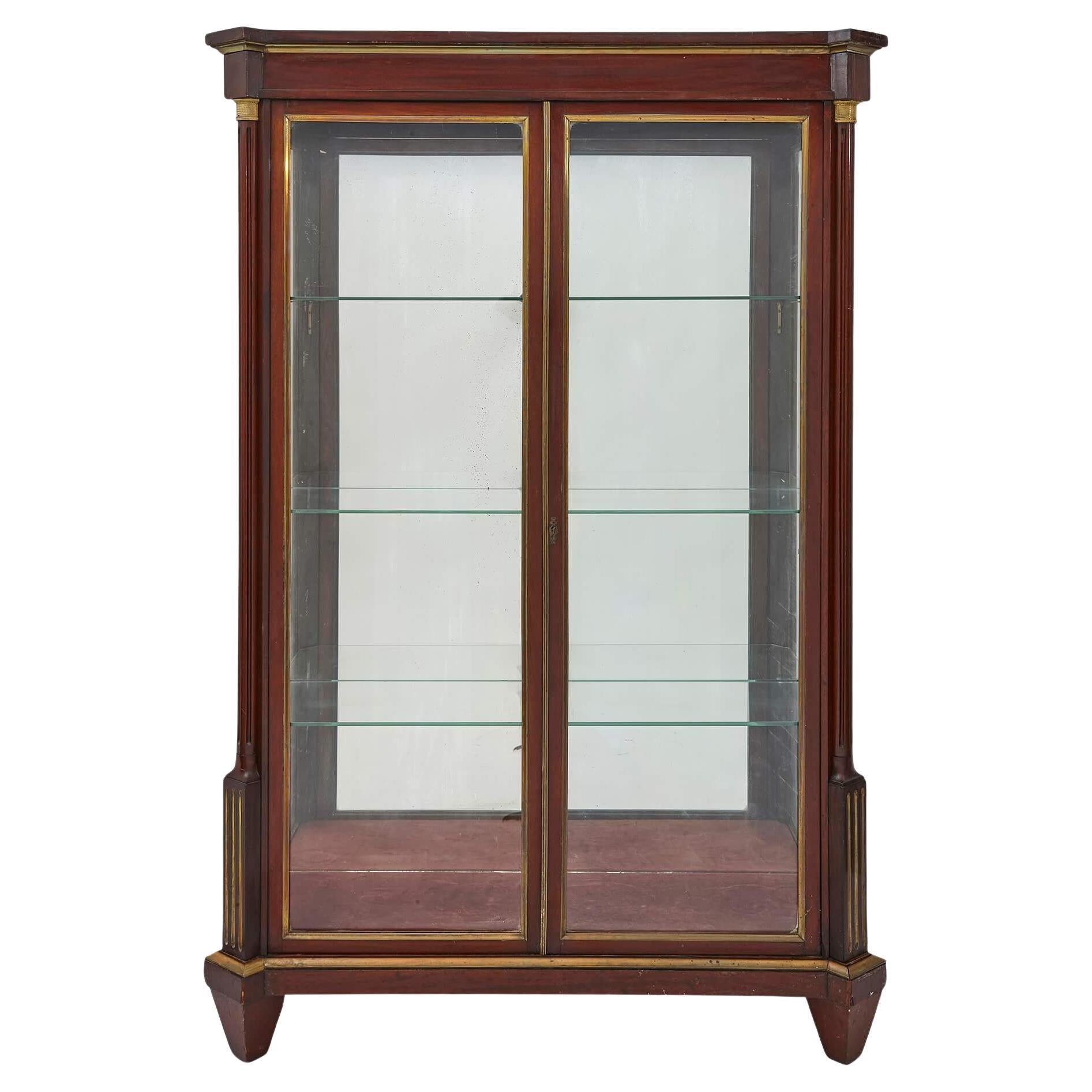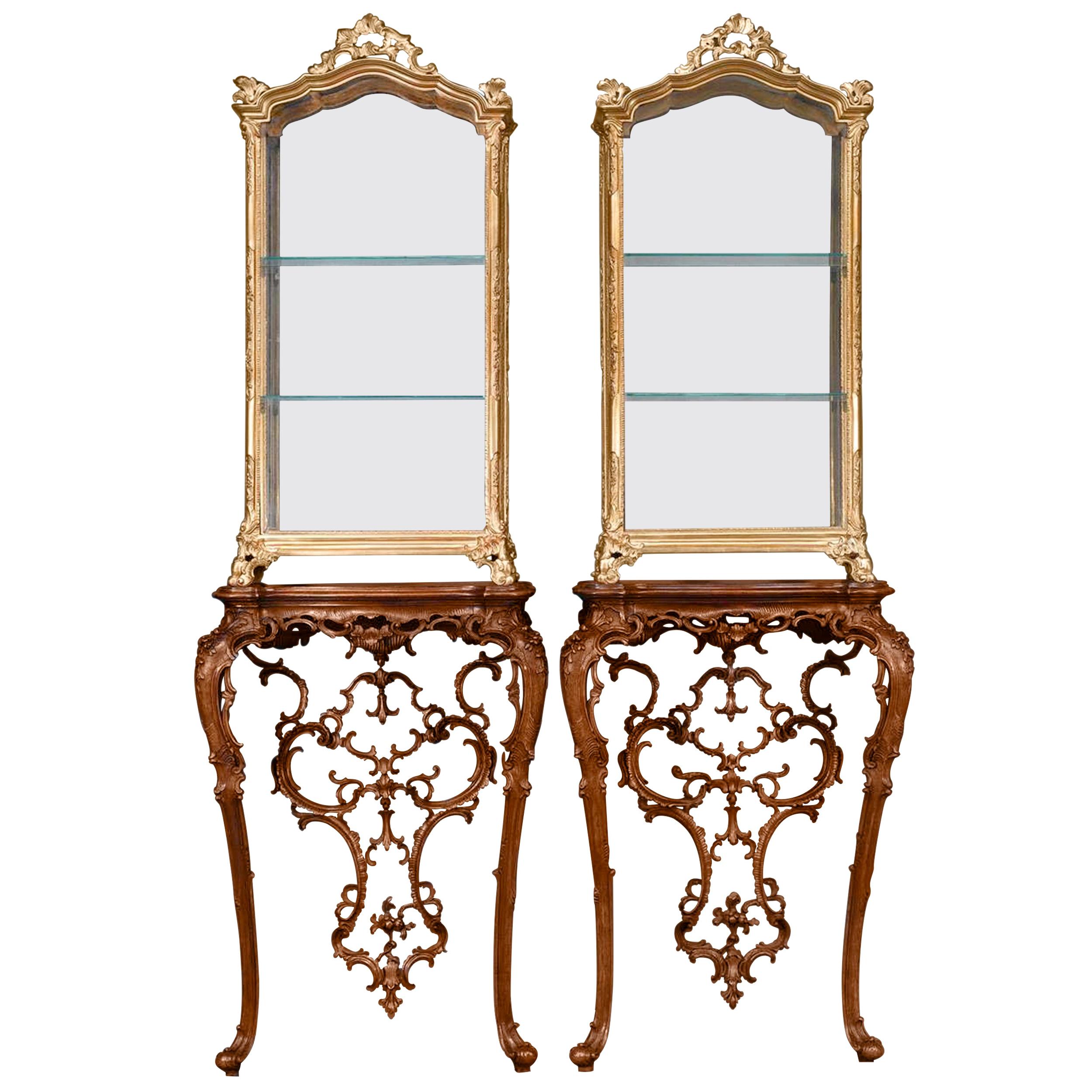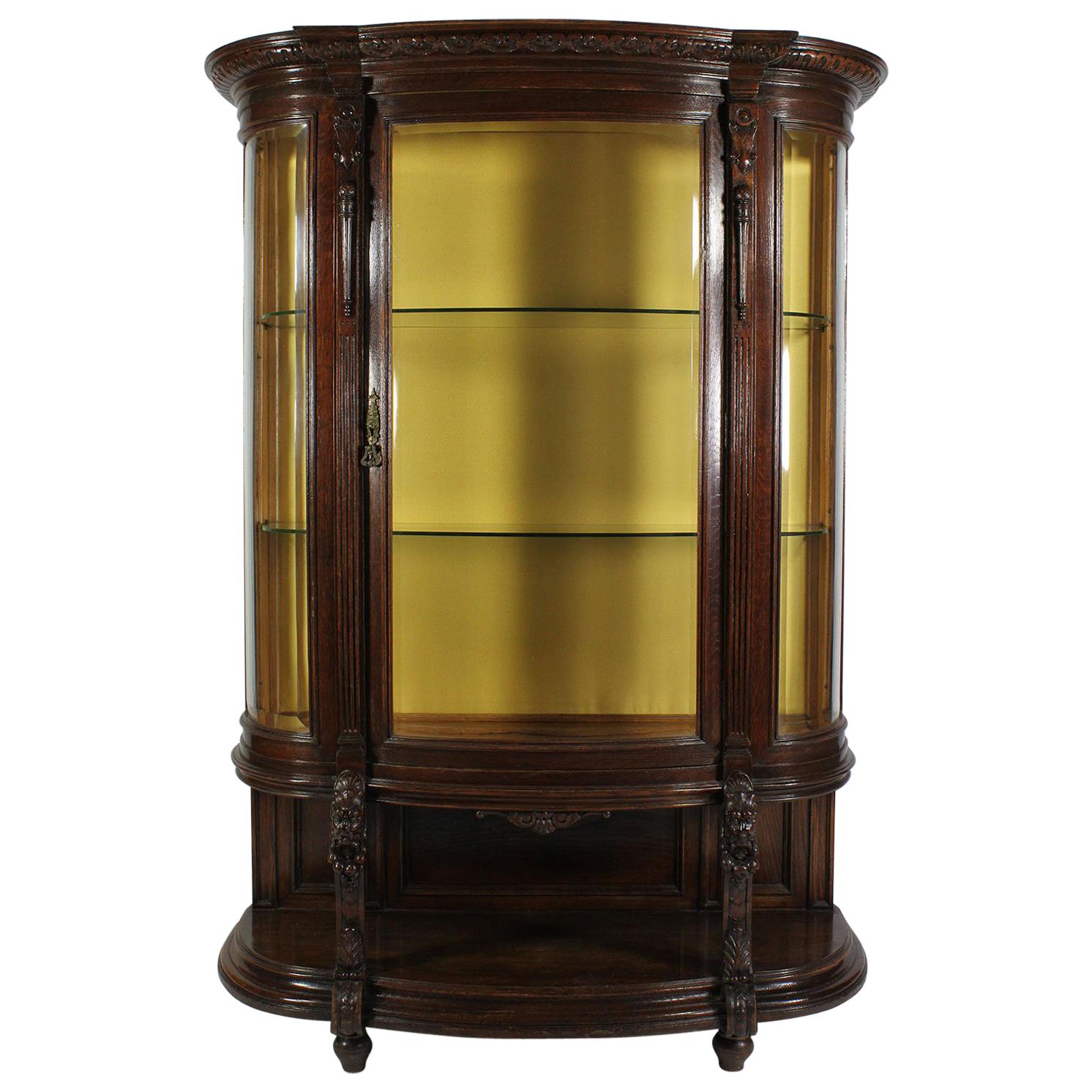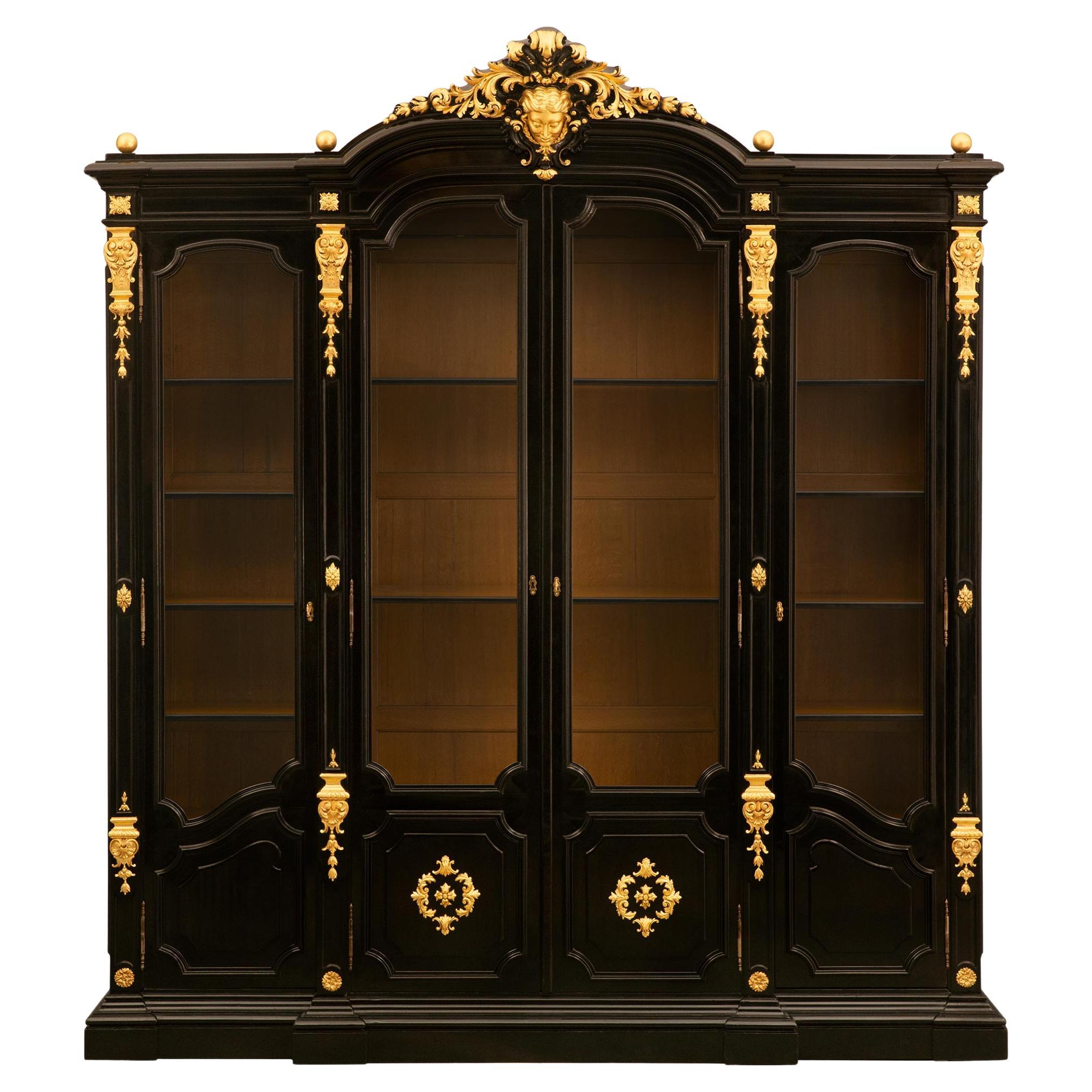Items Similar to Large 19 Century French Rococo or Neoclassical Revival Style Vitrine
Want more images or videos?
Request additional images or videos from the seller
1 of 21
Large 19 Century French Rococo or Neoclassical Revival Style Vitrine
About the Item
Stunning 19th century French Empire, neoclassical/Rococo Revival style Marquetry vitrine or display cabinet, of large proportions!!
A real statement piece!
Made of a fabulous variety of veneers, including kingwood, satinwood, tulipwood, harewood and walnut with quality classical ormolu mounts.
It has ebonized pillars in the Empire style, with walnut and exotic hardwood friezes in the Rococo style.
Double glass doors to middle section and single glass doors on either side.
The glass on the doors are framed in ormolu banding.
Floral Marquetry panels on front and parquetry on the sides.
The front central section is a pullout / pull-out drawers with gorgeous walnut frieze panel and original carved walnut knobs.
Scrolling pelmet on the top in 3 sections banded in ormolu beading.
Scrolling base with cabriolet feet and ormolu mounts on base.
Various ormolu mounts, floral mounts, mounts of Baachus and mounts of neoclassical female figures.
In 3 sections. with 2 side cabinets and large central section with 3 section pelmet, stunning piece!!!
The quality ormolu mounts are marked with the letter “R” and what appears to be “FR 678”.
We were originally of the belief that this piece might have been made at the very end of the 19th century, but having regard to the quality of workmanship throughout this piece we are of the opinion that it was most likely made in the third quarter of the 19th century, circa 1870 and by an obviously top quality Parisienne maker with a surname beginning with “R”.
It is definitely in the style of David Roentgen who was known for his Rococo/neoclassical styles.
David Roentgen, (born Aug. 11, 1743-died Feb. 12, 1807, Wiesbaden, Duchy of Nassau), cabinetmaker to Queen Marie-Antoinette of France; under his direction the family workshop at Neuwied (near Cologne), founded by his father, Abraham Roentgen, became perhaps the most-successful firm of furniture production in the 18th century.
After succeeding his father as head of the Neuwied workshop in 1772, Roentgen strove to broaden their clientele, an ambition that brought him first to Hamburg and ultimately to Paris (1774), where in 1779 he was spectacularly successful in selling his finest furniture to King Louis XVI of France for £3,300 to £4,000, an unprecedented sum for the time.
Appointed cabinetmaker to the queen, Roentgen was granted admission (1780) as maître-ébéniste (master cabinetmaker) to the trade corporation of Paris cabinetmakers, making it possible for him to keep in Paris a stock of the furniture manufactured at Neuwied. Thus he was able to compete with such great cabinetmakers as Jean-Henri Riesener and Adam Weisweiler, reputedly his former pupil at Neuwied. After his first visit to St. Petersburg, Empress Catherine II the Great bought huge quantities of his furniture; King Frederick William II of Prussia was also his client. When in 1795 the French Revolutionary armies threatened to cross the Rhine, Roentgen evacuated his establishment and moved his stock farther inland. Unfortunately, he lost everything in his Parisian salon and in his Neuwied workshop, both of which were sacked by Republican troops. He was crushed, despite his appointment as court furnisher to the king of Prussia. Although he never succeeded in starting production again, former apprentices of his whom he helped to establish in the German cities of Berlin (David Hacker) and Brunswick (Christian Härder) were successful.
The Rococo Revival style emerged in Second Empire France and then was adapted in England. Revival of the Rococo style was seen all throughout Europe during the 19th century within a variety of artistic modes and expression including decorative objects of art, paintings, art prints, furniture, and interior design. In much of Europe and particularly in France, the original Rococo was regarded as a national style, and to many, its reemergence recalled national tradition. Rococo Revival epitomized grandeur and luxury in European style and was another expression of 19th century Romanticism and the growing interest and fascination with natural landscape.
During the late half of the 19th century, Rococo Revival was also fashionable in American furniture and interior design. John Henry Belter was considered the most prominent figure of Rococo Revival furniture making. Revival of the Rococo style was not restricted to a specific time period or place, but occurred in several waves throughout the 19th century.
Roentgen had begun his career by continuing and developing the Rococo furniture that his father had introduced. The furniture of his “French” style is characterized by curved outline, sometimes decorated with rich carvings. His “English” cabinetwork is based on elements dating from the early years of King George III and occasionally influenced by the renowned furniture manufacturer Thomas Chippendale. Both national types are frequently decorated with rich inlay of outstanding charm and elegance composed of a variety of woods, some tinted and made to form figural and floral compositions, often in the manner of chinoiserie (Chinese motifs). Between 1775 and 1780 Roentgen abandoned his earlier styles in favor of rigid, classical forms, the effect of which is often based on contrasting mahogany with rich bronze appliqués, represented in his monumental combined secrétaire and medal-cabinet of circa 1785-1789. His workshop indulged in mechanical devices, a characteristic flair begun by his father, that made drawers and mirrors appear and disappear by pressing on hidden releases; Peter Kinzing invented many of these gadgets and provided the workshop with clockworks.
Seriously impressive and imposing piece of furniture!!!
Glass shelving in the interior. These are plate glass shelves with 3 in the central section and 3 each in the side cabinets. Using the floor of the display areas makes 4 shelving areas in each section. It has been wired for internal lighting with a touch button with 3 light settings.
Provenance: Bought at Auction in Ireland.
Made circa 1860-1870.
Dimensions: 88 inches (7.34 feet) high x 76 inches (6.34 feet) wide and 27 inches deep
Condition: Very good original condition. Has been re-gilded and some very minor professional repairs.
- Similar to:David Roentgen (Cabinetmaker)
- Dimensions:Height: 88 in (223.52 cm)Width: 76 in (193.04 cm)Depth: 27 in (68.58 cm)
- Style:Rococo Revival (Of the Period)
- Materials and Techniques:
- Place of Origin:
- Period:
- Date of Manufacture:1860-1870
- Condition:Repaired: Some minor repairs to the ormolu banding on the base. Re-gilted using 18 carat gold leaf. Wired for interior illumination. Wear consistent with age and use. Minor losses. Very good original condition. Has been re-gilted and some very minor professional repairs..
- Seller Location:Dallas, TX
- Reference Number:1stDibs: LU3978120225342
About the Seller
4.9
Gold Seller
These expertly vetted sellers are highly rated and consistently exceed customer expectations.
Established in 2015
1stDibs seller since 2018
349 sales on 1stDibs
Typical response time: <1 hour
- ShippingRetrieving quote...Ships From: Dallas, TX
- Return PolicyA return for this item may be initiated within 7 days of delivery.
More From This SellerView All
- Exceptional 19C French Empire Style Buffet/Vitrine by AME FournierBy A.M.E FournierLocated in Dallas, TXPRESENTING an OUTSTANDING, IMPORTANT and UNIQUE 19C French Empire Style Buffet/Vitrine by AME Fournier. Pieces by A.M.E. Fournier are EXTREMELY RARE and ...Category
Antique Late 19th Century French Empire Revival Credenzas
MaterialsSiena Marble, Ormolu
- 19C French Boudoir Vitrine in the Style of Louis XVLocated in Dallas, TXPresenting a beautiful and elegant 19th century French Boudoir vitrine in the style of Louis XV. From circa 1890 and made in France. This is a tall legged vitrine and has beaut...Category
Antique Late 19th Century French Louis XV Vitrines
MaterialsOrmolu
- 19C English Rococo Revival Ecclesiastical Oak Hall ChairLocated in Dallas, TXPRESENTING a FABULOUS 19C English Rococo Revival Ecclesiastical Oak Hall Chair. Made in England (Britain) circa 1870 in the Rococo Revival Style from solid oak. The large carved ac...Category
Antique 19th Century English Rococo Revival Chairs
MaterialsOak
- 19C French Gothic Revival Bench or StoolLocated in Dallas, TXPRESENTING A LOVELY 19C French Gothic Revival Bench/Stool or Organ Stool/Bench seat. Made in rural/provincial France (possibly Brittany) circa 1860-80 and in the Gothic Revival Style. We are of the opinion that the wood is ‘chestnut’ and not ‘oak’, as one would expect. The use of ‘chestnut’ makes this even RARER! Very ‘ecclesiastical’ in design and possibly would have been made for a Church, as the organ player’s stool/bench seat. Oblong/rectangular in shape. Unmistakably French, due to the base cross support design and construction, with circular central medallion (very ‘Breton’ in design) and wooden peg inserts for securing the base cross support on the outside of each side. This bench/stool is ‘nicer’ than most that have appeared on the market, due to it’s very good condition and the beautifully hand-carved decoration, beveled edges and raised arches on both sides. Also, the pair of carved gothic window-esque friezes on both sides, are a lovely touch! We are confident that this is a 19th Century piece, due to its natural aging, patina and when being re-upholstered it still had it’s original straw and horse (?) hair filling for the seat cushion. This Bench is part of an EXCEPTIONAL Private Dallas Collection. This Bench has IMPECCABLE PROVENANCE: It was purchased by an ancestor of the family (together with several other items also in the Collection), at a French Antique Auction held at the Club Room in the Stoneleigh Court (Hotel), Dallas on Wednesday the 2nd April 1930. (Now The Meridian Hotel). We have the Original Auction Catalog, which has remained with the Collection, since that Auction. (see photos). The Auction was titled: ” Works of Art and Furnishings of The Chateau de Turique (Nancy) and The Conde-Rougemont Home (Touraine). The cover of the Catalog also has a ‘seal’ of a Coat of Arms. The first page of the Catalog States: “Exhibition on Wednesday, April 2nd And Following Days From 10 A.M. to 10 P.M……EXHIBITION at CLUB ROOM, STONELIGH COURT, DALLAS, TEXAS”. The Second page gives a brief description of the Auction contents and states that ” This Exhibition will be presented by M. Fernand M. Adda of Paris France” This bench, we believe, was Lot No: 297 and was described in the Auction Catalog as: 297 – CARVED GOTHIC BENCH...Category
Antique 19th Century French Gothic Revival Benches
MaterialsChestnut
- 19th Century Louis XVI Style Cabinet in the Manner of Grohe FreresLocated in Dallas, TXPRESENTING a GORGEOUS late 19th Century French Louis XVI STyle Cabinet in the Manner of Grohe Freres. From circa 1880. ABSOLUTELY FABULOUS Ormolu mounts...Category
Antique Late 19th Century French Louis XVI Cabinets
MaterialsOrmolu
- Rare 19C Portois & Fix Viennese CabinetBy Portois & FixLocated in Dallas, TXPRESENTING A STUNNING and RARE 19C Portois & Fix Viennese Cabinet. Made by the famous and highly desirable maker, ‘Portois & Fix’ in Vienna, Austria ...Category
Antique Late 19th Century Austrian Belle Époque Cabinets
MaterialsOrmolu, Brass
You May Also Like
- Large Late 19th Century French Neoclassical Gilt Metal Mounted VitrineLocated in London, GBLarge late 19th century french neoclassical gilt metal mounted vitrine Measures: Height 184cm, width 121cm, depth 46cm This excellent display cabinet is a large late nineteenth c...Category
Antique Late 19th Century French Belle Époque Vitrines
MaterialsMetal
- Italian Rococo-Style Giltwood VitrinesLocated in New Orleans, LAThis extraordinary pair of Rococo-style vitrines is an exceptional example of Italian cabinetry. Beautifully designed and executed in giltwood, the stunning pair is set apart by a pr...Category
Antique 19th Century Italian Rococo Vitrines
MaterialsGiltwood
- French 19th-20th Century Baroque Revival Carved Oak Bombé Figural Bombé VitrineLocated in Los Angeles, CAA French 19th-20th century Baroque Revival carved oak Bombé figural vitrine. The single front-door display cabinet with bowed front and side beveled glass panels, with two interior g...Category
Antique Early 1900s French Baroque Revival Vitrines
MaterialsGlass, Oak
- An Italian 19th century Rococo Revival st. ebonized giltwood vitrineLocated in West Palm Beach, FLA most impressive and large scaled Italian 19th century Rococo Revival st. Ebonized Fruitwood and giltwood cabinet/vitrine. The four door cabinet is raised by a mottled plinth below ...Category
Antique 19th Century Italian Rococo Revival Vitrines
MaterialsGiltwood
- Swedish Rococo Style 19th Century Painted Vitrine with Glass Doors and DrawersLocated in Atlanta, GAA Swedish Rococo style painted wood vitrine from the 19th century, with bonnet top and glass doors. Born in Sweden during the 19th century, this exquisite vitrine features a bonnet-t...Category
Antique 19th Century Swedish Rococo Vitrines
MaterialsGlass, Wood
- Swedish Rococo Style 19th Century Painted Wood Vitrine Cabinet with Glass DoorsLocated in Atlanta, GAA Swedish Rococo style painted wood vitrine cabinet from the 19th century, with bonnet top, glass doors and bombé chest. Created in Sweden during the 19th century, this Rococo style cabinet...Category
Antique 19th Century Swedish Rococo Cabinets
MaterialsGlass, Wood
Recently Viewed
View AllMore Ways To Browse
Antique Door Plates And Knobs
Antique Door Knob And Plate
Antique Door Knob Plate
Antique Door Knobs And Plates
George Iii Style Carved Mirror
George II Walnut Mirrors
George Ii Style Mirror
Mahogany 3 Door Display Cabinet
Antique Door Knobs With Plates
Antique 3 Section Mirror
English Adam Mirror
Mirror American Revival
American Rococo Revival
19 Century Cabinets Storage Shelving
Henry 2 Cabinet
American Made China Cabinets
Mirror Second Empire
French Walnut 2 Door Side Cabinet





